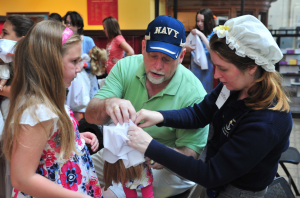
American Girl Logo
Before 1986, the only dolls that girls had to choose from were Barbies. All that changed when American Girl dolls burst unto the scene. Unlike other toys, they weren’t in stores, and were instead purchased through direct mail. They were also different than Barbies because they had stories from different time periods like WWII, and their adventures were chronicled in book series that touched on serious topics like child factory labor, poverty, abuse, slavery, and war. Now, the American Girl Dolls are iconic. Who came up with the idea?
In 1984, Pleasant Rowland traveled to Williamsburg, Virginia. She loved how history came alive there, with reenactment tours complete with costumes and storytelling. As a teacher, Rowland knew how poorly schools taught history, and wondered if there was a war she could make the topic more interesting to children. A few months later, she was shopping for dolls for her nieces, but didn’t want Barbies or Cabbage Patch Kids. Inspired by her trip to Williamsburg, she decided to create dolls that embodied significant times for women, so that history could become more real for young girls.
The Pleasant Company came to be and went to work. At first, focus groups were baffled by the idea, but once they actually saw the dolls complete with historically-accurate clothing, they were sold. Big companies that Rowland went to for advice also thought the dolls would bomb, especially since the dolls were going to cost close to $100. However, in just three months, the Pleasant Company brought in nearly $2 million. By 1989, it had hit $30 million.
The first three dolls were Molly from WWII, Samantha from the turn of the 20th century, and Kirsten, from the mid-19th century. The American Girl headquarters had a library as part of all the dolls’ development, where the staff of three librarians and historian stored information, clothing ideas, and more. Until 1993, all the dolls were white. Then Addy came along.
Addy’s development was unusual because she had a formalized advisory board comprised of black scholars and historians. Accuracy was very important to Rowland, and the story of Addy, a 9-year old born into slavery, unfolded through the doll and subsequent books. Addy has been both loved and criticized as a character who teaches young girls about slavery, but also exploits a stereotype of the “suffering slave” narrative. The next POC doll didn’t come along until 2002. Kaya was the 8th historical character and a member of the Nez Perce tribe. Like with Addy, there was a board of experts and the company (now owned by Mattel) got approval from the tribe. It took five years to create Kaya, and the doll has been praised.
Mattel bought Pleasant Company in 1998, and began a shift towards more contemporary dolls. It was most likely a money-motivated decision, because they could release more stuff. 66 dolls have been released with different face shapes, eye color, skin tone, and so on. Original fans of the dolls weren’t too happy, because it stripped American Girl of its historical origins. Now, the dolls were about appearance, and lacked the groundbreaking stories. The company still funds education for girls and has events for doll owners like “Girls Make History Day” where they can learn about the times their dolls are from. Many of the original historical dolls have even been archived, so they aren’t available for purchase anymore. If you wanted one, you’d have to look on sites like ebay, where a Molly doll will cost you upwards of $300.





